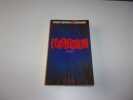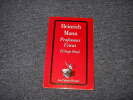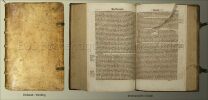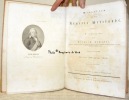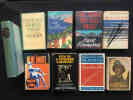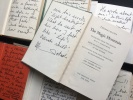3672 books for « heinrich p »Edit
-
Type
Book (3656)
Engraving (1)
Magazine (1)
Maps (4)
Music sheets (12)
-
Latest
Last 3 days (2)
Last month (42)
Last week (6)
-
Language
Dutch (1)
English (2)
French (3596)
German (18)
Italian (1)
Latin (1)
Portuguese (1)
Russian (54)
-
Century
16th (4)
17th (25)
18th (130)
19th (528)
20th (1425)
21st (85)
-
Countries
Belgium (243)
Brazil (1)
Canada (2)
China (1)
Côte d'Ivoire (4)
Denmark (224)
France (2134)
Germany (12)
Greece (10)
Italy (10)
Spain (10)
Switzerland (966)
United Kingdom (1)
United States of America (56)
-
Syndicate
ALAC (2)
CLAM (5)
CLAQ (1)
CNE (3)
ILAB (2236)
NVVA (404)
SLACES (404)
SLAM (1266)
SNCAO (1)
Topics
- Alps (49)
- Alsace (18)
- Anatomy (64)
- Archaeology (27)
- Architecture (16)
- Army (57)
- Asia - orient (15)
- Austria (18)
- Basel (9)
- Bible (13)
- Biography (36)
- Boll heinrich (170)
- Botany (11)
- Chemistry (9)
- Children’s books (41)
- China (8)
- Dedication (9)
- Dictionaries (25)
- Drawings (14)
- Early printed books (9)
- Economics (22)
- Education (21)
- Education - morals (14)
- Engraving (books about) (22)
- Engravings (35)
- Ethnology (13)
- Europe (10)
- Fine arts (26)
- First edition (26)
- Fraenkel heinrich (11)
- Genealogy (12)
- Geography (46)
- Geology (13)
- German literature (37)
- Germanic languages (309)
- Germany (101)
- Greece (8)
- Harrer heinrich (26)
- Hebraic literature (9)
- Heine henri (146)
- Helvética (291)
- History (203)
- Hoffmann (23)
- Hoffmann heinrich (9)
- India (12)
- Industrial arts & crafts - fine arts (18)
- Italian (10)
- Italy (9)
- Jacob (17)
- Kleist heinrich von (45)
- Law (37)
- Linguistics (17)
- Literature (180)
- Mann thomas (112)
- Manvell roger (10)
- Mathematics (17)
- Medicine (56)
- Memories (9)
- Military arts (39)
- Mountaineering climbing (25)
- Music (18)
- Newspaper (12)
- Newspapers press (15)
- North america (9)
- Painters (9)
- Painting (17)
- Philology (22)
- Philosophy (69)
- Photography (15)
- Physics (31)
- Poetry (17)
- Policy (16)
- Portraits (13)
- Psychology (13)
- Religions (66)
- Review (9)
- Russia (13)
- Schubert f. (12)
- Schutz (12)
- Sciences (15)
- Scores (43)
- Sociology (10)
- Songs (16)
- Switzerland (226)
- Tea (13)
- Technology (10)
- Theatre (32)
- Theology (48)
- Tibet (10)
- Tibet pc (14)
- Topography (13)
- Translation (11)
- Travel (22)
- Various (27)
- War (67)
- Zoology (17)
- Zurich (63)
PROFESSEUR UNRAT ( l'ange bleu)
petit format, couverture souple. 283 pages.bon état 1983 Grasset . Les cahiers rouges
Cohausen, Heinrich Joseph, (Band 2: Cohausen, Salentin Ernst Eugen):
Reference : 50437BB
(1757)
Europae arcana medica id est: Collectanea physico-medica-practica ex Ephemeridum Germaniae naturae curiosorum vastis voluminibus studiose in compendium redactata: id est in quibus continetur omne id laconicè contractum, quod praxin medicam concernens in Ephemeridum G.N.C. Libris sprasim legitur, H.E. omnia arcana, experimenta et remedia polychresta ab experimentissimis Europae medicis multo usu approbata et consignata.
2 Bände. Frankfurt und Leipzig, Knoch & Esslinger 1757-1760. 8°. 10 n.n. Bl., 598 (recte 596) S., 18 n.n. S. Index; 32 n.n. S., 398 S., 18 n.n. S. Index. Schöne Halblederbände der Zeit mit je 2 goldgeprägten verschiedenfarbigen Rückenschildern und reicher ornamentaler Rückenvergoldung.
Blake 92. (Nur Band 1). - Wellcome 2, 366. - Hirsch 6, 636 (für Salentin Ernst Eugen). - Erste Ausgabe. - Pharmazeutische Rezeptsammlung für und gegen alles. Die biographischen Quellen sind widersprüchlich. Nach Hirsch war Salentin Cohausen (1703-1779) der Neffe von Johann Heinrich Cohausen, was jedoch mit der Aussage Hirschs, dass Johann Heinrich der Verfasser des vorliegenden Werkes sei, nicht übereinstimmt. Ferguson hat das Problem auch erkannt "There were several Cohausen, and Haller, warns his reader against confounding them. He himself however, is a little bit vague and seems to mix them" (Ferguson 1, 169). Das Vorwort des ersten Bandes ist datiert mit 1757. Johann Heinrich starb bereits 1750. Heinrich Joseph nennt sich auf dem Titel "Phil. & Medicinae Doctoris, Vredenae Westphalorum Pysici". - Fliegende Vorsätze mit zeitgenössischem Stempel. Papier gleichmässig etwas gebräunt. Band 2 mit kleiner Wurmspur im Innendeckel und den ersten 20 Blatt. - Dekorativ gebunden.
Buch der Bündth-Ertznei. Herausgegeben von H. Haeser und A. Middeldorpf.
Berlin, Reimer, 1868, gr. in-8vo, XLIV + 1 Bl. (= Nachtrag mit Untersteichungen in blau) + 179 + 1 S. Stempel auf Titelbl., vereinzelt unterstreichungen, Orig.-Halbleinen. Schönes Exemplar
Heinrich von Pfolspeundt Bruder des deutschen Ordens 1460 (auch von Phaltzpingen, fälschlich von Pfolsprundt), ein deutscher Wundarzt, lebte in der Mitte des 15. Jhdts. und gehörte wahrscheinlich dem adeligen Geschlechte an, welches in dem gleichnamigen Orte, gegenwärtig Pfalzpaint an der Altmühl, unterhalb Eichstädt, angesessen war. (.) Pfolspeundt ist wohl überhaupt der erste Wundarzt, der Schusswunden sowie Rhinoplastik erwähnt, als erster Deutscher beschreibt er die Anwendung von 'Schlafschwämmen". "Hier find sich (erstmals?) der Ausdruck »hassen schartten«DAZU: Christian Probst: Zwei unbekannte Briefe des chirurgen Heinrich von Pfalzpaint aus dem Jahre 1453. 12 S. (SA. ,.Aus Sudhoffs Archiv Bd, 50 März 1966). EA. Vgl. Corradi, 67-268; Gurlt, II, 196; Hirsch, V, 555.

(SLACES, NVVA)
Phone number : 41 (0)26 3223808
Cohausen, Heinrich Joseph, (Band 2: Cohausen, Salentin Ernst Eugen):
Reference : 35064DB
(1757)
Europae arcana medica id est: Collectanea physico-medica-practica ex Ephemeridum Germaniae naturae curiosorum vastis voluminibus studiose in compendium redactata: id est in quibus continetur omne id laconicè contractum, quod praxin medicam concernens in Ephemeridum G.N.C. Libris sprasim legitur, H.E. omnia arcana, experimenta et remedia polychresta ab experimentissimis Europae medicis multo usu approbata et consignata.
2 Bände. Frankfurt und Leipzig, Knoch & Esslinger 1757-1760. 8°. 10 n.n. Bl., 598 (recte 596) S., 18 n.n. S. Index; 32 n.n. S., 398 S., 18 n.n. S. Index. Schöne Halblederbände der Zeit mit je 2 goldgeprägten verschiedenfarbigen Rückenschildern und reicher ornamentaler Rückenvergoldung.
Blake 92. (Nur Band 1). - Wellcome 2, 366. - Hirsch 6, 636 (für Salentin Ernst Eugen). - Erste Ausgabe. - Pharmazeutische Rezeptsammlung für und gegen alles. Die biographischen Quellen sind widersprüchlich. Nach Hirsch war Salentin Cohausen (1703-1779) der Neffe von Johann Heinrich Cohausen, was jedoch mit der Aussage Hirschs, dass Johann Heinrich der Verfasser des vorliegenden Werkes sei, nicht übereinstimmt. Ferguson hat das Problem auch erkannt "There were several Cohausen, and Haller, warns his reader against confounding them. He himself however, is a little bit vague and seems to mix them" (Ferguson 1, 169). Das Vorwort des ersten Bandes ist datiert mit 1757. Johann Heinrich starb bereits 1750. Heinrich Joseph nennt sich auf dem Titel "Phil. & Medicinae Doctoris, Vredenae Westphalorum Pysici". - Fliegende Vorsätze mit zeitgenössischem Stempel. Papier gleichmässig etwas gebräunt. Band 2 mit kleiner Wurmspur im Innendeckel und den ersten 20 Blatt. - Dekorativ gebunden.
Romantiques allemands, Tome 1 (Bibliothèque de la Pléiade)
Gallimard Bibliothèque de la Pléiade Reliure d'éditeur 1981 In-12 (11 x 17,5 cm), reliure d'éditeur pleine peau sous demi-jaquette, rhodoïd et étui muet, XXXVII-1606 pages, ce volume contient : Jean Paul : Vie de Fixlein, Régent de Cinquième - Le Jubilé «Appendice». Novalis : Les Disciples à Saïs - Heinrich von Ofterdingen. Friedrich Schlegel : Lucinde. Ludwig Tieck : La Coupe d'or - Eckbert le Blond - Le Runenberg - Les Elfes - Les Amis - Vie de l'illustre Empereur Abraham Tonelli. E.T.A. Hoffmann : Le Vase d'or - La Princesse Brambilla - Don Juan - Kreisleriana. Heinrich von Kleist : La Marquise d'O... - Le Duel - Le Tremblement de terre du Chili - Les Fiancés de Saint-Domingue - L'Enfant trouvé - La Mendiante de Locarno - Michael Kohlhaas. Frédéric de La Motte-Fouqué : Ondine - La Mandragore. Appendice 1-Jean Paul : Quelques «jus de tablette» pour les Messieurs. 2-Novalis : Notice de Ludwig Tieck sur Heinrich von Ofterdingen. 3-Wilhelm Wackenroder : Vision de Raphaël - La Remarquable vie musicale du compositeur Joseph Berglinger - Le Merveilleux conte oriental du saint homme nu. 4-Johann Joseph von Görres : Saint François d'Assise troubadour - Notices sur A.W. Schlegel et Zacharias Werner, volume publié sous la direction de Maxime Alexandre ; bel exemplaire Livraison a domicile (La Poste) ou en Mondial Relay sur simple demande.
Prometheus. Für Licht und Recht. Zeitschrift in zwanglosen Heften, herausgegeben von Heinrich Zschokke und seinen Freunden.
3 Bände (alles was erschienen). Aarau, Im Verlag von Heinrich Remigius Sauerländer. 1832-1833. VIII, 294 S., 1 Bl.; 328 S.; 299 S., 1 S. Halblederbände der Zeit mit roten Rückenschildern und wenig Rückenvergoldung.
Goedeke X, 104, 109. - Kirchner II, 7592. - Diesch 1734. - Seltene komplette Folge der wichtigen Zeitschrift. Die Zeitschrift konnte in dieser Autorenzusammensetzung und den Themen nur ausserhalb Deutschlands erscheinen. Der Wegfall der Zensur und die umfassenden Beziehungen Zschokkes zu den deutschen Intellektuellen, gerade in Paris, verhalf der Zeitschrift zu wichtigen Beiträgen von Autoren die auch heute noch verkannt sind: Karl Gustav Jochmann, Gustav von Schlabrendorf, K. E. Oelsner, Karl V. von Bonstetten, Alois Redding und Heinrich Zschokke selbst. - Durchgehend mässig stockfleckig. Vorsätze mit Leimschatten. - In guten berner Halblederbänden der Zeit.
Heinrich Zschokke’s Rede an die helvetische Gesellschaft zu Schinznach. Besonderer zufolge förmlichen Beschlusses der Gesellschaft veranstalteter Abdruck.
Aarau, Heinrich Remigius Sauerländer, 1829, in-8vo, 32 S., marmorierter Pappband.
Das Verhältnis der Helvetischen Gesellschaft zum Zeitalter. Rede an die Versammlung der helvetischen Gesellschaft. Gehalten in Schinznach am 12. Mai 1829 von ihrem Vorsteher Heinrich Zschokke, Mitglied des grossen Raths vom K. Aargau.

(SLACES, NVVA)
Phone number : 41 (0)26 3223808
Wochenschrift für Menschenbildung von Heinrich Pestalozzi und seinen Freunden. Erster Band, Erstes bis fünfzehntes Stück
1. Band (von 4). Aarau, bei Heinrich Remigius Sauerländer, in Commission bei Heinrich Gräff in Leipzig. 1807. VIII, 248 S. Pappband der Zeit mit Marmorpapierbezügen.
Goedeke XII, 62, 18. - Kirchner. - Seltene erste Ausgabe des ersten (von 4) Jahrganges von Pestalozzis programmatischer pädagogischer Zeitschrift. "Das Niveau dieser Zeitschrift ist bedeutend ... und auch heute noch lesenswert durch ihre Probleme und die belebende Form der literarischen Darbietung." (Kirchner, Das deutsche Zeitschriftenwesen, S. 210). - Enthält in Band 1, Heft 7-9 den zentralen Aufsatz Pestalozzis aus dem Jahre 1799 'Pestalozzi und seine Anstalt in Stans.' - Name auf Titelblatt. - Fleckenloses Exemplar.
Laube Heinrich. Geschichte der deutschen Literatur. History of German Literature
Laube Heinrich. Geschichte der deutschen Literatur. History of German Literature. Volume 1 and Volume 2. In German (ask us if in doubt)/Laube Heinrich. Geschichte der deutschen Literatur. Istoriya nemetskoy literatury. Tom 1 i tom 2. In German. Gothic font. Stuttgart Hallberger 1839. 323 and 317s. We have thousands of titles and often several copies of each title may be available. Please feel free to contact us for a detailed description of the copies available. SKUalb39d257c5aa34ec0a
STAADT Heinrich - Hofbuchhandlung Wiesbaden - Julius Baum - Ernst Oppler - Franz Werfel - Hermann Struck - Emil Orlik - Arthur Schnitzler - Max Brod - [...] ( Einträger ) :
Reference : 43500
Gästebuch der Hofbuchhandlung Heinrich Staadt Wiesbaden. 1921 - 1928 .
".: Wiesbaden, Hofbuchhandlung Heinrich Staadt, 1921 - 1928, in-4° Album, 31 x 25 cm, ca. 400 unpaginated pages, bound in full red morocco with gilt ruling and title on the front cover, five raised bands and gilt title on the spine, marbled endpapers, top edge gilt. ( Signed binding H. Fikentscher Leipzig 1920). Binding with minor traces of use, some edges of the uncut leaves a bit browned but the album is in a fine state of preservation. Interesting guestbook of the bookdealer company Hofbuchhandlung Heinrich Staadt Wiesbaden which contains the signatures, the contributions, the original drawings of many postwar artists and literary figures in Germany during the Weimar period. Many of the signatories were of Jewish origine and would be obliterated from German cultural life within the next decade. Some names ; Waldemar Bonsels , Liesbeth Dill , Friedrich Hübner (drawing) , Friedrich von T.? , Hans Christiansen ( portrait drawing) , Walter Jacob (drawing) , E. Frank (portrait drawing) , Leo Sternberg , Felix Merem (portrait drawing ) , ? Jasper , Fried Lübbecke , Karl Berger , Alfred Bock , Konrad Dreher , Bertha Freifrau von Nauendorf , Christian Heinrich Kleukens , Max Thalman , Alexander Eliasberg , Dimitri Mereschkovsky , Rudolf Dietz ( poem ) , Siegfried Wagner , Herman Struck , Eric Franck (drawing ) , Adam Karillon , Ernst Horneffer, Ernst Oppler (drawing of a ballerina ) , Emil Orlik , Arthur Schnitzler , Max Brod (text) , Adolf von Hatzfeld , Hermann Kesser , Colin Ross, Friedrich Schönemann [...] In all there are 54 entries ; 1 music stave , 8 drawings, 33 with a text , 12 signatures. Some of the entries were not identified by us.."
SCHMIDINGER, Heinrich / DOPSCH, Heinz / KOLLER, Heinrich / KRAMML, Peter F.:
Reference : 111930aaf
Patriarch im Abendland. Beitr. zur Gesch. des Papsttums, Roms und Aquileias im Mittelalter.
Salzburg, St. Peter, 1986, gr. in-8vo, XXIV + 464 S., Widmung, signiert von Heinrich Schmidinger, Original-Leinenband mit OU.

(SLACES, NVVA)
Phone number : 41 (0)26 3223808
Haussbuch. Darinn Fünfftzig Predigten Heinrich Bullingers dieners der Kirchen zu Zürych: In wlchem nicht allein die X. Gebott Gottes die XII. Artickel dess Christlichen Glaubens das H. Vatter unser und die Lehr von H. Sacramenten: sonder auch alle andere Artickel Lehren und Hauptstuck unserer Christlichen Evangelischen Religion weytläuffig einfältig und ordentlich gehandelt und erklärt werden. Zuuor nuh etliche mal in Lateinischer sprach im Truck aussgangen: Jetzo zu mehrerem undericht und trost allen Gottes und seines Worts liebhabenden Christen auffs newe ubersehen auss dess Authoris selbs hinderlassenene Schrifften vermehret unnd sampt desselbigen Catechismo, auff die gemeine hochteütsche sprach mit sonderbarem fleyss zugerichtet.
Zürich, Johann Wolf, 1598. 4°. (20), 405, (21) Bl. Blindgeprägter Schweinslederband auf Holzdeckeln mit mit 2 Metallschliessen.
VD16 B-9704. - Staedtke: Heinrich Bullinger - Bibliographie 195 u. 381 (Catechismus). - Vierte deutsche Ausgabe. Erschien erstmals 1552 in Lateinisch und 1558 auf Deutsch, übersetzt von Johannes Haller, der den lateinischen Titel "Sermonum - Decades quinque" mit "Hausbuch - Darinn begriffen werden fünfzig Predigen ..." übersetzte. Diese "sind nicht nur eine Sammlung von Predigten, sondern eine Dogmatik, welche seit ihrem erstmaligen Erscheinen 1549 bis 1551 eine wichtige Rolle in den theologischen Auseinandersetzungen vorab in den Niederlanden und in England spielte" (Staetke, 1679 - Hollweg, W.: Heinrich Bullingers Hausbuch). Der Catechismus erschien erstmals zusammen mit der ersten deutschen Ausgabe (1558). - Durchgehend gebräunt und stockfleckig. Blatt 272 mit grösserem Einriss mit Papier- und Textverlust. Einband berieben, bestossen und fleckig.

Phone number : 41 (0)44 261 57 50
-Wanderfrüchte. Sammlung auserlesener Poesien aller Zeiten in Uebertragungen, von Johann Friedrich Heinrich Schlosser. -Gedichte von Johann Friedrich Heinrich Schlosser. -Legenden von Johann Friedrich Heinrich Schlosser. Aus dessen Nachlass herausgegeben von Sophie Schlosser. In einem Band.
Mainz, Franz Kirchheim 1856-1857, 145x100mm, XII-, VIII- , VI- 332 + 164 + 135Seiten, Chagrin-Halbledereinband. Deckeln aus Perkalin. Stockflecken. Guter Zustand.
Pour un paiement via PayPal, veuillez nous en faire la demande et nous vous enverrons une facture PayPal
Miscellen (Miszellen) für die Neueste Weltkunde. 2 Bände. - Erster Jahrgang 1807. 104 Nr. Mit dem Bildnisse Sr. Hoh. des Fürst-Primas, 1 colorierte Karte, Plan der Versumpfungen Wallensee, Bildnisse Sr. Maj. des Königs von Baiern. - Zweiter Jahgang, 1808.104 Nr. Mit vier Kupfern, nebst evirschen Beiblättern und Intelligenzblättern. (Bildisse König von Würtemberg, Jérôme Napoléon Koenig von Westphalen, 1 Bildnisse von Lord Keith, Arthur Young, Lord Duncan, etc.) Fehlt ein Kupfern?
Aarau - Basel, im Verlag der Samuel Flick’schen Buchhandlung - Heinrich Remigius Sauerländer 1807-1808, 300x210mm, Pappband.
7 Bl., 416 Seiten, 2 Bl., mit Beilagen, 1 Bl., 416 Seiten, 7 Bl., Pour un paiement via PayPal, veuillez nous en faire la demande et nous vous enverrons une facture PayPal
Naturgeschichte des Pflanzenreichs nach dem Linnschen System
. 54 fein koloriete Doppelfoliotafeln mit ber 650 naturgetreuen Abbildungen und 93 seiten erluterndem Text. Nach G.H. v. Schuberts Lehrbuch der Naturgeschichte neu bearbeitet von Moritz Willkomm... Mit einer Vorrede von Gotthilf Heinrich v. Schubert. Vierte vermehrte Auflage. Eklingen, J.F. Schreiber, (1887). [viii], vii, [i], 77 pp. Folio (23 x 33 cm.). Original half publisher's cloth with pictorial front board (faded and rubbed along the board edges; corners slightly bumped; spine discoloured, top and bottom worn). With 54 very fine double-page coloured wood engraved plates (42 x 32,5 cm.). Parfait état !
Meisterbilder aus Tirols Alpenwelt / Originalaufn. v. Otto Melzer. Text v. Heinrich von Ficker
1921 Berlin [u.a.] : Preuss' Institut Graphik, [1921]. - 51 S. : Ill.
bon état, Remise de 20% pour toutes commandes égales ou supérieures à 100 €
Brugsch Heinrich: The History of the Pharaohs. In Russian /Brugsh Genrikh. Ist
Brugsch Heinrich: The History of the Pharaohs. In Russian /Brugsh Genrikh. Istoriya faraonov. Tyre Room 5, Moscow Publishing House, V. Sekachev, 2015, 924s. We have thousands of titles and often several copies of each title may be available. Please feel free to contact us for a detailed description of the copies available. SKUalbfecabe5427642338.
Lithographierte Ausgabe von Keller’s Erster Reisekarte der Schweiz.
Zürich, Verlag von Heinrich Keller, 1846, in-8vo (gefaltet), 66x48 cm, lithogr. Karte Stempel auf Rückseite: „Robert Zapp, Anstreicher Glaser Farbwarenhandlung, Volberg b/ Bensberg“.
Karte auf Leinwand montiert: mit eingefärbten Grenzen, Wasserflächen und Schneegipfeln der Alpen (blau), in den Ecken kleine Übersichtskarten mit den wichtigsten Reiserouten aus der Schweiz in die Nachbarländer, mehrfach gefaltet, 12 Segmente (12x22 cm) auf Leinen aufgezogen, Rückseite (aussen wenn gefaltet) mit Verlagswerbung für Landkarten, Pläne, Profile, Panoramen und Ansichten von Heinrich Keller, Leinen an Faltkanten teilweise eingerissen, ansonsten guter Zustand. Image disp.

(SLACES, NVVA)
Phone number : 41 (0)26 3223808
Heine Heinrich. Germany. A Winters Tale. In Russian /Geyne Genrikh. Germaniya.
Heine Heinrich. Germany. A Winters Tale. In Russian /Geyne Genrikh. Germaniya. Zimnyaya skazka. Translation and Notes by Lev Penkovsky. Foreword by F. Shiller. Second revised edition. M.-L. ACADEMIA. 1936. XXVIII, 258 p. We have thousands of titles and often several copies of each title may be available. Please feel free to contact us for a detailed description of the copies available. SKUalb875cbcdb69ded589.
Heine Heinrich. Germany. A Winters Tale. In Russian /Geyne Genrikh. Germaniya.
Heine Heinrich. Germany. A Winters Tale. In Russian /Geyne Genrikh. Germaniya. Zimnyaya skazka. Translation by Yuri Tynyanov. With 1 map and 31 drawings. Moscow-Leningrad. GIHL. 1933. 215s. We have thousands of titles and often several copies of each title may be available. Please feel free to contact us for a detailed description of the copies available. SKUalb0effe2923a342c7f.
Heine Heinrich. Complete collection of works in 12 volumes 1, 3,4,5,6,7,9,10,11
Heine Heinrich. Complete collection of works in 12 volumes 1, 3,4,5,6,7,9,10,11,12 In Russian /Geyne Genrikh. Polnoe sobranie sochineniy v 12 tomakh. 1, 3,4,5,6,7,9,10,11,12 Under the joint editorship of I. Berkovsky and I. Luppol. Admission by Georgy Lukach. Academia 1936-1938. Academia-Art Literature 1935-1939. We have thousands of titles and often several copies of each title may be available. Please feel free to contact us for a detailed description of the copies available. SKUalbedd70142748b82a2.
Heine Heinrich. A complete collection of works in twelve volumes. Volume V. Nov
Heine Heinrich. A complete collection of works in twelve volumes. Volume V. Novels. Articles. In Russian /Geyne Genrikh. Polnoe sobranie sochineniy v dvenadtsati tomakh. Tom V. Novelly. Stati. Under the general editorship of N. Ya. Berkovsky and I. K. Luppol. Translation under the editorship of A. A. Metalov. Comments by Ya. M. Morozova. Series: German Literature. ACADEMIA 1937. 381 p. We have thousands of titles and often several copies of each title may be available. Please feel free to contact us for a detailed description of the copies available. SKUalbd9eaf9038d1852f4.
Heine Heinrich. Jewish motives. In Russian /Geyne Genrikh. Evreyskie motivy.
Heine Heinrich. Jewish motives. In Russian /Geyne Genrikh. Evreyskie motivy. Translation by Peter Weinberg. With the attachment of a portrait and an article by Stordtman Heine and Jewishness by St. Petersburg Publishing House Bussel. 1902. 129c. We have thousands of titles and often several copies of each title may be available. Please feel free to contact us for a detailed description of the copies available. SKUalbb3f49cb76d5086ce.
DIETRICH, Marlene - AUDEN,W. H., COWARD, Noël, HEMINGWAY, Ernest, MANN, Heinrich, MANN,Thomas, PAUSTOVSKY, Konstantin, REMARQUE, Erich Maria, RILKE, Rainer Maria, STERNBERG, Josef von.
Reference : 3758
(1960)
EXCEPTIONAL SET OF NINE BOOKS INCRIBED WITH MARLENE DIETRICH'S AUTOGRAPH SIGNED RECOLLECTIONS (two to four pages in length each) of her relationship with their authors :
Exceptional set of nine books inscribed with Marlene Dietrich’s autograph signed recollections (two to four pages in length each) of her relationship with their authors, each of whom has played a prominent role in Dietrich’s life, including former lovers, very close friends and writers whose works had made the most thorough impression on the actress. Each volume has been specially selected around the year 1979 by Dietrich among the books owned by a friend of hers. This set reflects in a unique way the passions of one of the most iconic actress of the twentieth century. - It includes: - 1. AUDEN (W. H. ). Collected Shorter Poems 1927-1957. New York, Random House, [1967]. Inscribed in black felt pen by Marlene Dietrich: « A true friend in special, difficult times ; also a favorite writer - although his style is so different from other great poets! Just shows you how varied my taste was, - and is! » - 2. COWARD (Noël). Pomp and Circumstance. Garden City, Doubleday, 1960. Inscribed in black felt pen by Marlene Dietrich: « When he introduced my performance at the “Café de Paris” in London it seemed to me as if a king had stepped down from his throne to help up a fallen commoner: We were friends for many, many years. Not even our travelling to many different countries could devide us! After his coming to rest in Switzerland I almost lived there between my professional escapades. I relied on his advice and I always felt guilty that I could do nothing in return. He insisted though, that my presence, near or far, had become a necessity for him, his mind, his phantasies! Maybe he made this up in order to minimize my guilt. I am grateful that I was not there when he died! My usual courage failed. » - 3. HEMINGWAY (Ernest). For whom the bell tolls. New York, Collectors Reprints, [1968]. Inscribed in black felt pen by Marlene Dietrich: « He wrote about me : “In this life Dietrich makes her own rules - but her own laws of decency and conduct in human behavior and relations are not less strict than the original ten.” This is one of the reasons he chose me to be his friend and intimate ». - 4. MANN (Heinrich). The Blue Angel. The novel by Heinrich Mann. The film by Josef von Sternberg. New York, Frederick Ungar, 1979. The volume includes The Blue Angel, English translation of Heinrich Mann’s Professor Unrat, and the English script of Der blaue Engel, its adaptation made by Josef von Sternberg. The book on which was based the movie to which Marlene Dietrich owned the iconic role which made her famous. Inscribed in black felt pen by Marlene Dietrich: « A sad man - living in the shadow of his famous, highly talented brother. He had a rare stream of contentment when his book “Professor Unrat” was chosen by Mr. von Sternberg for the first sound-film in Germany - as a vehicle for the famous star Emil Jannings. He felt very honoured and grateful to Mr. von Sternberg, and gave him “Plein-Pouvoir” to make all the changes he wanted - character and story changes. I never saw him again after the film called “BLUE ANGEL” was filmed in its final form, but I heard that he was not in the least upset regarding the drastic changes his book suffered in the version that made the film a lasting classic. - 5. MANN (Thomas). The Magic Mountain. Translated from the German by H. T. Lowe-Porter. With an introductory essay by the author. Illustrated with wood engravings by Felix Hoffmann. The Heritage Press, New York. Inscribed in black felt pen by Marlene Dietrich: “To read all the books written by Thomas Mann belonged to the higher education I received. I was fascinated by the “BUDDENBROCKS”, but the “MAGIC” of this book made me dizzy with admiration, or to use his words “light-hearted”! What he said of his hero I felt like “Life’s delicate child”. - 6. PAUSTOVSKY (Konstantin). Story of a Life. Childhood... Translated by Manya Harari and Michael Duncan. London, Harvill Press, 1964. Picture of Dietrich and Paustovsky at Moscow in 1964. Inscribed in black felt pen by Marlene Dietrich: « I am still on my knees at his feet like I was in Moscow when he came onto the stage at the end of my concert. I had read his books and found my own passions brilliantly described as his own! I had written to him long before I went on tour to Russia, but I never dreamt of meeting him - let alone feeling his hands touch mine! » - 7. REMARQUE (Erich Maria). All Quiet on the Western Front. Translated from the German by A.W. Wheen. New York, Grosset & Dunlap [reprint of the 1930 edition]. Picture of Dietrich and Remarque. Inscribed in black felt pen by Marlene Dietrich: « My great friend and “COMRADE IN ARMS”. Remember: his books were burnt at the historical “REICHTAGS-FIRE”. I arranged for his untroubled stay in America and it amused him when he caught me re-reading his books over and over again in the three languages I knew, “All quiet” and “The Road back” in particular. He was so full of complexes that I thought it my duty to eliminate at least some and I was proud when I succeeded. A sentimental gentleman he was. His favorite song: “Que reste-t-il de nos amours”. Also at the end of “All quiet on the Western Front” the Butterfly -. (Apart from the irony). He was a timid man and undemanding — Easy to live with. What a Loss! » - 8. RILKE (Rainer Maria). Translations from the Poetry of Rainer Maria Rilke by M.D. Herter Norton. New York, W.W. Norton, [1938]. Inscribed in black felt pen by Marlene Dietrich: « His is my God!! His writings, but especially his POEMS, ALL HIS POETRY helped me through the dark hours of life making my constant enthusiasm chase away all the melancholy my realism evokes daily. - I know all poems by heart and I take special delight in his unequaled choice of words and descriptions of his subjects, but also the “double-ryme” he invented - like a magician creating visual events and observations, rising out of the printed word, into living reality, right in front of your eyes! Sheer Delirium!! » - 9. STERNBERG (Josef von). Fun in a Chinese Laundry. New York, The Macmillan Company, [1965]. First edition of this autobiography, by the director who made Marlene Dietrich famous and made several of her greatest movies. Inscribed by Marlene Dietrich: « I quote the “FEMME FATALE” he made of me in Hollywood: “THE MAN I WANTED TO PLEASE MOST”. THERE I was alone - THERE he was the ultimate Tyrant at the studio. REASON: he knew about all the intricate parts of everything involved in Film-creation. Better than anybody - camera-men, lighting-men, (scriptwriters too) and he did not hide that fact! He had some patience with actors, but they hated him too: superiority is not easy to love. The INFERIORITY-COMPLEX, hidden in every human mind does not allow to love the man who knows all. - I am the exception to the rule! I loved him, I respected him, I bowed to his unusual behavior and I admired and worshipped his knowledge and wisdom. Both were the cause of his troubled existence. I cried a lot though! That’s when he said: “Everybody go to lunch Miss Dietrich is crying.” He did not pity me - then ».
More pictures on request.
 Write to the booksellers
Write to the booksellers